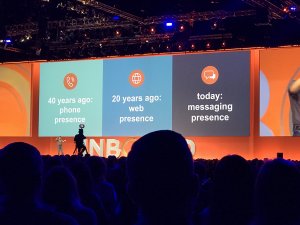While many of our colleagues and partners were tempted by our offer of discounted tickets to this year’s INBOUND conference put on by HubSpot (part of the perks of being a HubSpot Certified Agency Partner), many could not make it. I promised them I would write with some of the highlights, so here they are. Please let me know if you were there too, and what you learned.
Authenticity is powerful.
While the word “authentic” was woven through many of the marketing presentations, there was no more clear example of the power of authenticity than Michelle Obama. She was interviewed by Roxanne Gay (another phenomenal woman) and spoke with the grace and sincerity than can only result from a strong sense of self. She is clearly comfortable with who she is and how she helps (we’d say her “core branding” is excellent).
This inner strength allowed her to not just give answers that were honest and thoughtful but also discuss what happens when folks are not authentic. It was truly inspirational.
The “authenticity” theme was brought up time and time again as HubSpot rolled out a slate of products that will help businesses and organizations have more authentic conversations with those they serve about strategic goals and real business needs rather than about generic features and pricing. As someone who believes deeply in understanding the people you serve, these tools have me very excited.
The Nonprofit and Social Impact world can learn a lot from the business world.
There were not many sessions devoted to nonprofit marketing, but so much of what I learned over the week will be tremendously useful to the organizations looking to do good in the world.
For example, many of the tools HubSpot are aimed at making the “customer journey” as smooth and efficient as possible, transforming a prospect from a stranger to a delighted customer. However, nonprofits rarely think this way and often the people in the position to help a social good organization most are the ones given the least thought.
Many of the organizations I’ve worked with want to speak to everyone in the same way at the same time. What results is a cacophony (I’ve written about how to avoid that here). To help all organizations think about those they serve, HubSpot emphasizes using “personas” or sample profiles that represent a slice of your target audience. Businesses serving other businesses (B2B) do this really well. They know (often personally) the clients they serve, and that knowledge can drive very targeted campaigns. I’d love to see the nonprofit world get much more specific about the audiences it targets.
We don’t need to do it all, all the time.
Inbound marketing is a vast and rapidly changing landscape filled with new technologies, new practices, and changing expectations. There is the temptation to chase after every bright, shiny new tool that pops up promising better returns on investment.

The good news is that we don’t have to do it all at the same time. Many of the presentations I attended gave some version of the same advice: Start small and experiment. Try working out the kinks in the system with a small project and then scale based on what you learn. HubSpot is at its core a learning organization. While the tools are fairly simple and intuitive to learn, we get better and better the more we use them.
And that’s what HubSpot wants—for everyone to get better and better. That’s what Inbound is all about.
